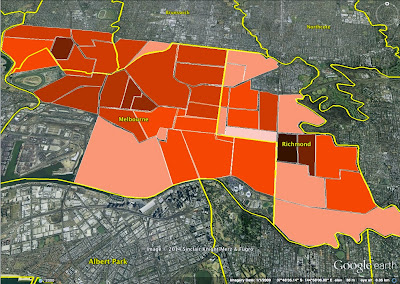But I don't want to have this discussion online, or at least not publicly online. There's a lot going on here, and the dust is still settling. But the reality is that the warning I sounded to the few poor souls whose throats I forced my 25,000 word essay down has essentially come to pass, and even sooner than I feared. We have all but run third in 2016 in the seat where in 2001 Lindsay Tanner secured a 48% primary vote.
So I'm not risking putting any more grist in our opponents' mill by putting any more of our ideas in the public arena. Here's the raw data. I'm extremely eager to hear anyone's spin on it, to know whether anyone can see a way forward here. Or does this essentially advise us "it's cooked, move on"?
None of the demographic trends at work show any sign of reversing, nor do they seem like the sorts of things election campaigns can really much impact. The only booths we won at the last poll were Housing Commission booths - and we still managed to lose half of those, or booths where a high Liberal vote got us over the 2PP line. Does this feel terminal, or what?
I've reproduced the images from my earlier blog post here also to help give some more historical context/trend. You'll note I've changed my methodology. Working with the area-based "lozenges" was a bit more visually engaging but an absolute pain in the digital arse. Especially when particular booths come and go from poll to poll.
These 2016 numbers of course exclude absentee and declaration votes, but the reality is those are obviously NOT going to alter the more demonstrable trends.
Anyway, I'll let the data speak for itself, and hopefully you, dear reader, may also be moved to do similarly. You know where to find me.
 |
| Melbourne FEA Booths by 2PP vote %, 2016 Federal Poll Bright Green = GRN 50-60%, Deep Green = GRN 60%+ Orange = ALP 50-60%, Red = ALP 60%+ |
 |
| Melbourne FEA Booths by ALP Primary Vote %, 2016 Federal Poll Pink = 10-20%, Light Orange = 20-30%, Deep Orange = 30-40%, Red = 40-50% |
 |
| Melbourne FEA Booths by GRN Primary Vote %, 2016 Federal Poll Pale Green = 30-40%, Bright Green = 40-50%, Deep Green = 50-60% |
 |
| Melbourne FEA Booths by ALP Primary Swing %, 2016 Federal Poll Pale Green = -0-1%, Bright Green = -1-5%, Deep Green = -5%+ Light Orange = +0-1%, Dark Orange = +1-5%, Red = +1-5%+ |
And frankly, I think this next one is one of the most interesting charts of all. And this is basically where I'm coming from when I forecast that the entire inner city is just going to be one massive three way contest in the not too distant future.
 |
| Melbourne FEA Booths where highest 1st pref swing was to the LIBERALS, 2016 Federal Poll |
The remaining older charts show primary voting patterns (no 2PP) for Federal Elections 2013 and 2010 plus Melbourne State District Byelection 2012. State electoral boundaries are shown in yellow. Lighter red = lower ALP vote %. Lighter green = lower GRN vote %. Colours are consistent in their % representation across all images.
 |
| ALP Primary Vote, 2010 Federal Poll |
 |
| ALP Primary Vote, 2013 Federal Poll Indicating the huge decline in ALP votes in central, north and eastern parts of the electorate |
 |
| ALP Primary Vote, 2012 State Byelection |
 |
| ALP Primary Vote, 2010 Federal Poll, overlaid with State Byelection 2012 showing little shift in ALP primary vote between these polls in booths within the State District boundaries |
 |
| ALP Primary Vote, 2013 Federal Poll, overlaid with State Byelection 2012 showing a huge decline in ALP primary vote between these polls in booths within the State District boundaries |
 |
| GRN Primary Vote, 2010 Federal Poll |
 |
| GRN Primary Vote, 2013 Federal Poll showing significant increase in GRN primaries across Northern-Central portion of electorate |



No comments:
Post a Comment